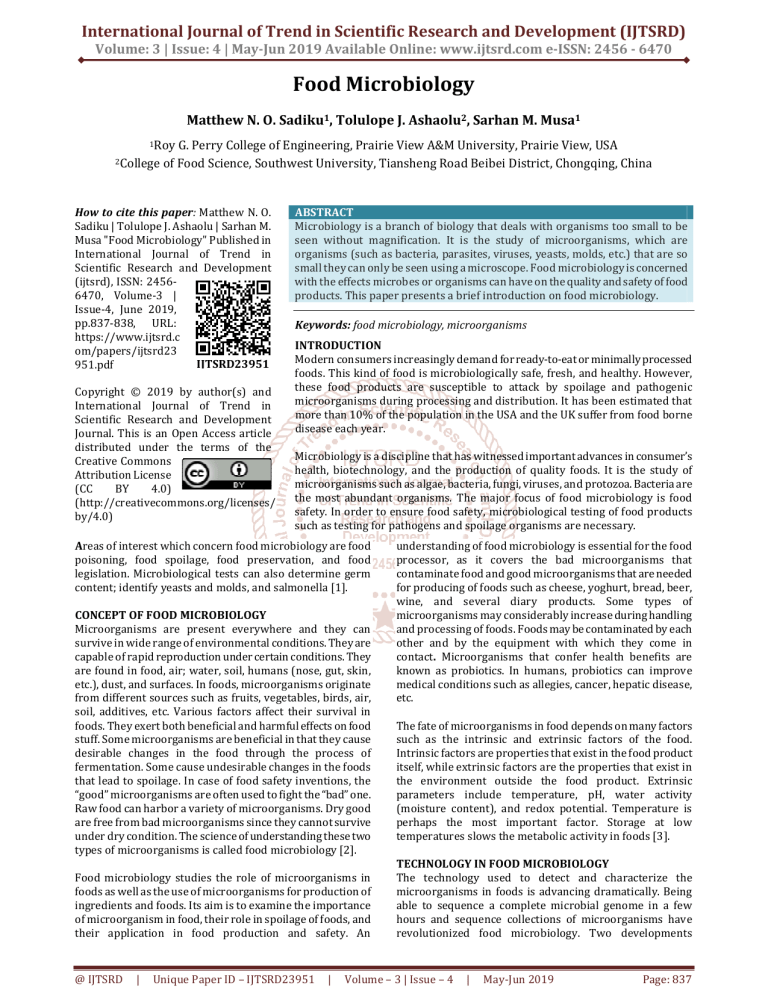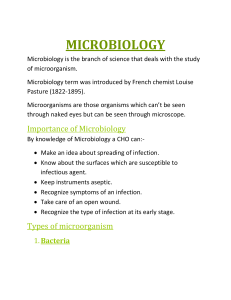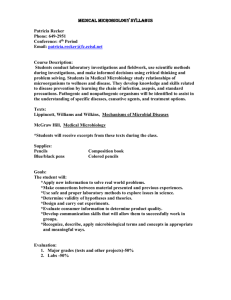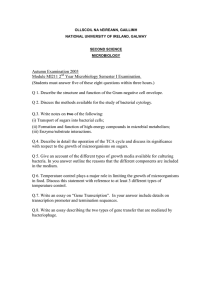
International Journal of Trend in Scientific Research and Development (IJTSRD) Volume: 3 | Issue: 4 | May-Jun 2019 Available Online: www.ijtsrd.com e-ISSN: 2456 - 6470 Food Microbiology Matthew N. O. Sadiku1, Tolulope J. Ashaolu2, Sarhan M. Musa1 1Roy 2College G. Perry College of Engineering, Prairie View A&M University, Prairie View, USA of Food Science, Southwest University, Tiansheng Road Beibei District, Chongqing, China How to cite this paper: Matthew N. O. Sadiku | Tolulope J. Ashaolu | Sarhan M. Musa "Food Microbiology" Published in International Journal of Trend in Scientific Research and Development (ijtsrd), ISSN: 24566470, Volume-3 | Issue-4, June 2019, pp.837-838, URL: https://www.ijtsrd.c om/papers/ijtsrd23 IJTSRD23951 951.pdf Copyright © 2019 by author(s) and International Journal of Trend in Scientific Research and Development Journal. This is an Open Access article distributed under the terms of the Creative Commons Attribution License (CC BY 4.0) (http://creativecommons.org/licenses/ by/4.0) ABSTRACT Microbiology is a branch of biology that deals with organisms too small to be seen without magnification. It is the study of microorganisms, which are organisms (such as bacteria, parasites, viruses, yeasts, molds, etc.) that are so small they can only be seen using a microscope. Food microbiology is concerned with the effects microbes or organisms can have on the quality and safety of food products. This paper presents a brief introduction on food microbiology. Keywords: food microbiology, microorganisms INTRODUCTION Modern consumers increasingly demand for ready-to-eat or minimally processed foods. This kind of food is microbiologically safe, fresh, and healthy. However, these food products are susceptible to attack by spoilage and pathogenic microorganisms during processing and distribution. It has been estimated that more than 10% of the population in the USA and the UK suffer from food borne disease each year. Microbiology is a discipline that has witnessed important advances in consumer’s health, biotechnology, and the production of quality foods. It is the study of microorganisms such as algae, bacteria, fungi, viruses, and protozoa. Bacteria are the most abundant organisms. The major focus of food microbiology is food safety. In order to ensure food safety, microbiological testing of food products such as testing for pathogens and spoilage organisms are necessary. Areas of interest which concern food microbiology are food poisoning, food spoilage, food preservation, and food legislation. Microbiological tests can also determine germ content; identify yeasts and molds, and salmonella [1]. CONCEPT OF FOOD MICROBIOLOGY Microorganisms are present everywhere and they can survive in wide range of environmental conditions. They are capable of rapid reproduction under certain conditions. They are found in food, air; water, soil, humans (nose, gut, skin, etc.), dust, and surfaces. In foods, microorganisms originate from different sources such as fruits, vegetables, birds, air, soil, additives, etc. Various factors affect their survival in foods. They exert both beneficial and harmful effects on food stuff. Some microorganisms are beneficial in that they cause desirable changes in the food through the process of fermentation. Some cause undesirable changes in the foods that lead to spoilage. In case of food safety inventions, the “good” microorganisms are often used to fight the “bad” one. Raw food can harbor a variety of microorganisms. Dry good are free from bad microorganisms since they cannot survive under dry condition. The science of understanding these two types of microorganisms is called food microbiology [2]. Food microbiology studies the role of microorganisms in foods as well as the use of microorganisms for production of ingredients and foods. Its aim is to examine the importance of microorganism in food, their role in spoilage of foods, and their application in food production and safety. An @ IJTSRD | Unique Paper ID – IJTSRD23951 | understanding of food microbiology is essential for the food processor, as it covers the bad microorganisms that contaminate food and good microorganisms that are needed for producing of foods such as cheese, yoghurt, bread, beer, wine, and several diary products. Some types of microorganisms may considerably increase during handling and processing of foods. Foods may be contaminated by each other and by the equipment with which they come in contact. Microorganisms that confer health benefits are known as probiotics. In humans, probiotics can improve medical conditions such as allegies, cancer, hepatic disease, etc. The fate of microorganisms in food depends on many factors such as the intrinsic and extrinsic factors of the food. Intrinsic factors are properties that exist in the food product itself, while extrinsic factors are the properties that exist in the environment outside the food product. Extrinsic parameters include temperature, pH, water activity (moisture content), and redox potential. Temperature is perhaps the most important factor. Storage at low temperatures slows the metabolic activity in foods [3]. TECHNOLOGY IN FOOD MICROBIOLOGY The technology used to detect and characterize the microorganisms in foods is advancing dramatically. Being able to sequence a complete microbial genome in a few hours and sequence collections of microorganisms have revolutionized food microbiology. Two developments Volume – 3 | Issue – 4 | May-Jun 2019 Page: 837 International Journal of Trend in Scientific Research and Development (IJTSRD) @ www.ijtsrd.com eISSN: 2456-6470 changed the landscape of microbial diagnostics – nucleic acid sequencing and polymerase chain reaction (PCR). Both evolved out of the field of recombinant DNA technology.. PCR is a fast and inexpensive method to generate numbers of copies of a DNA fragment at a specific band. The detection of bacterial strands in food products is very important because it helps prevent the occurrence of food borne illness. A major challenge is reducing the detection techniques to practical usage across the entire spectrum of foods [4]. PREDICTIVE FOOD MICROBIOLOGY Food microbiology has always been an active area of mathematical modeling and has followed the trend of the medical sector, driven by the need for reliable analysis. The need to assure the microbiological safety has stimulated interest in the use of mathematical modeling to quantify and predict microbial behavior. Predictive food microbiology (PFM) is an emerging area of food microbiology which encompasses such disciplines as mathematics, microbiology, engineering, and chemistry. Predictive food microbiology is based on the assumption that the responses of microorganisms to the environmental factors are reproducible and that it is possible to predict their responses in certain environments. Predictive microbiology has been so widespread that it is now one of the most rapidly advancing of the sub-specialties in food microbiology. It could be a boon to food microbiologists, allowing them to rapidly explore the microbiological impact of varying conditions within a food. It has the potential of becoming significant element supporting microbiological safety of food in the future. The careful implementation of predictive microbiological techniques into academic institutions and industry is critical to its continued use and acceptance [5]. More information on microbiology of foods can be found in numerous books in [1, 7-17] and the two journals exclusively devoted to it International Journal of Food Microbiology, and Industrial Food Microbiology. REFERENCES [1] “Food microbiology,” Wikipedia, the free encyclopedia https://en.wikipedia.org/wiki/Food_microbiology [2] S. Ravishankar and N. Maks, “Basic food microbiology,” in G. Tewari and Vijay K. Juneja (eds.), Advances in Thermal and Non-Thermal Food Preservation. Ames, IO: Blackwell Publishing, chapter 1, 2007. [3] H. M. Hungaro et al., “Food microbiology,” Encyclopedia of Agriculture and Food Systems, vol. 3, 2014, pp. 213231. [4] C. A. Batt, “Technology in food microbiology,” Reference Module in Food Sciences, 2016. [5] K. McDonald and D. W. Sun, “Predictive food microbiology for the meat industry: A review,” International Journal of Food Microbiology, vol. 52, 1999, pp. 1–27. [6] R. L. Buchanan, “Predictive food microbiology,” Trends in Food Science & Technology, vol. 4, January 1993. [7] N. M. Khardori (ed.), Food Microbiology: In Human Health and Disease. Boca Raton, FL: CRC Press, 2016. [8] T. J. Montville, K. R. Matthews, and, K. E. Kniel, Food Microbiology: An Introduction. ASM Press, 4th ed., 2017. [9] J. M. Jay, M. J. Loessner, and D. A. Golden, Modern Food Microbiology. Springer, 7th ed., 2005. [10] G. J. Banwart, Basic Food Microbiology. New York: Chapman & Hall, 2nd ed., 1989. The revived interest in mathematical modeling of food microbiology is due to three reasons [6]: (1) There is ready availability of powerful computers, (2) There is a need to quantify the effects of factors contributing to the total microbiological integrity of food products, (3) The models can provide the food industry with information to make informed decisions about the safety of food products. [11] W. F. Harrigan, Laboratory Methods in Food Microbiology. San Diego, CA: Academic Press, 1998. CONCLUSION Food microbiology is the study of the microorganisms that can inhabit, create, or contaminate food and which have both beneficial and deleterious effects on the quality of food. It is a huge area that encompasses such disciplines as mathematics, microbiology, engineering, and chemistry. Food safety is a major concern of food microbiology as well as a major challenge for global food sector. The golden era of food microbiology has begun. [14] B. Ray, Fundamental Food Microbiology. Boca Raton, FL: CRC Press, 3rd ed., 2005. @ IJTSRD | Unique Paper ID – IJTSRD23951 | [12] C. S. Pederson, Microbiology of Food Fermentations. Avi Publishing, 1971. [13] P. R. Hayes, Food Microbiology and Hygiene. Springer, 2nd ed., 1995. [15] M. L. Tortorello, Encyclopedia of Food Microbiology. San Diego, CA: Academic Press, 2nd ed., 2014. [16] M. P. Doyle and R. L. Buchanan, Food Microbiology: Fundamentals and Frontiers. ASM Press, 4th ed,, 2013. [17] B. Ray and A. Bhunia, Fundamental Food Microbiology. Boca Raton, FL: CRC Press, 5th ed., 2014. Volume – 3 | Issue – 4 | May-Jun 2019 Page: 838




